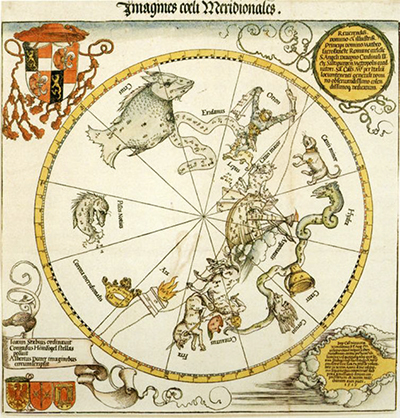Albrecht Durer was inspired by two beatiful Nuremburg maps and decided to produce his own versions which are separated into the Northern and Southern Skies
Whilst witnessing these beautiful articles of cartography around 1503 it was not until around 1505 that he got around to producing his own versions. It is highly likely that he would have visited the items of inspiration on several occasions, during to their location in his home town of Nuremburg.
Famously, within his Northern version there are famous astronomers placed into each corner of the artwork, which was certainly his own idea and not something that was found in the original artworks that initially interested him in cartography.
This particular map contains the crest of Cardinal Lang von Wellenburg as an additional item chosen by Durer. Also included are his family's coats of arms and the Imperial copyright. It is not known why he chose to include the Cardinal, though in other artworks he would place the artwork's commissioner into the piece, so this is the most likely explanation.
Rather interestingly is that the two woodcuts are believed to have been the first printed star maps in Europe, which is a bold but believable claim when placing his work in line with the historic development of the printing method. Perhaps the innovation and variety of Durer's work is one of his finest qualities and certainly helps him to stand out amongst the other members of the Northern Renaissance.
Whilst Durer is recognised as one of the key members of the Northern Renaissance, it is a greater significance to this series that Imagines coeli Septentrionalis et Meridionalis zodiac is actually well respected by historical astronomers.




